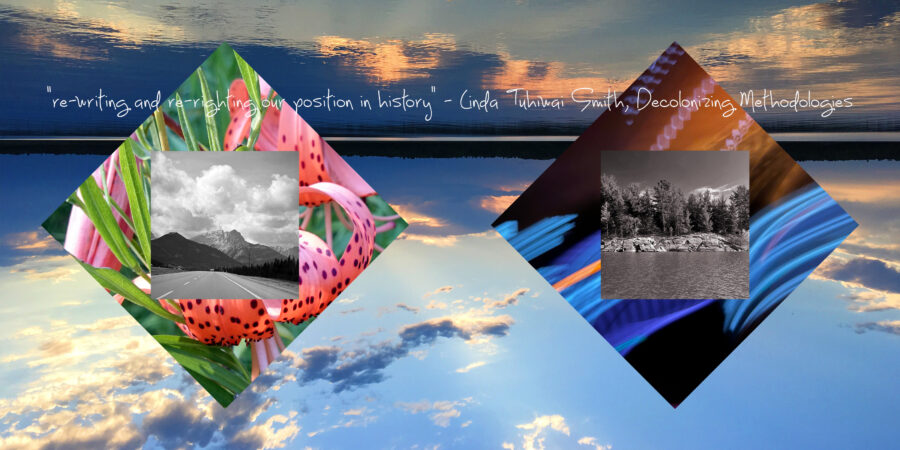
Boozhoo indinawemaaganidog. Mikinaak nindodem miinawa go Nanigiigonebiig nindigoo. Susan Blight indizhinikaaz zhaaganaashiiwinikaazoyaan igo gaye. Ningii-nitawig imaa iwidi sa besho Gojijing. Mii wa’aw niin eyaawiyaan.
My English name is Susan Blight. I am an Anishinaabe visual artist, educator, researcher, and editor from Couchiching First Nation, specifically from the Morrisseau and Morrison families of the Anishinaabe Nation of Treaty #3. I have lived in Toronto since 2010, where I have worked on several land- and place-based projects that aim to bring Indigenous histories to the surface and attend to the original place names of the city. I come to this work as an Anishinaabe person commited to creating opportunities for Indigenous peoples to tell our own stories in our own ways on our own terms, or, as Linda Tuhiwai Smith has written, with a view to “rewriting and rerighting our position in history.”1
As a central facet of settler-colonialism, the renaming of Indigenous lands by colonial powers is both erasure and replacement. Settler-colonialism is predicated on, as Haunani Kay-Trask writes, “the obliteration rather than the incorporation of Indigenous peoples” and this includes the destruction of any material signs of our living presence.2 Indigenous languages—repositories of our ways of knowing and being—are sonic and textual sovereign doings which articulate our nation- and tribal-specific spatial understandings. When spoken, read, and seen, our languages work against colonial erasure and encourage meaningful engagement with (and in) place.
We recognize the renaming of lands and waters by settlers as a particularly effective tool of colonization. It is a method of alienating Indigenous people from our own territories and obscuring the Indigenous history and jurisdiction of the land. Even place names that originate from Indigenous languages are robbed of authentic Indigenous presence or connection to the Indigenous histories of that location. People may know that Kamloops, Winnipeg, Ottawa, and Toronto have their origins in Secwepemctsin, Ininímowin, Omàmìwininìmowin, and Kanien’kéha, and yet know nothing of the complex personal and adaptive relational practice of place-naming by Indigenous peoples. This lack of understanding renders these toponyms just words for a place rather than an understanding of space-time. Christi Belcourt writes that Canadians are quite comfortable with these names, but only so long as they are Indigenous in name only, “and don’t come with the burden of acknowledging Canada’s past colonialist history and the erasure of Indigenous ownership of lands.”3 The action of restoring and revitalizing Indigenous place names goes beyond inclusion, equity, and reconciliation into something that is deeply political and transformative on multiple scales.
This work has been ongoing and Indigenous people have fought hard to have our place names in their rightful place. In doing so, we have asserted and reanimated historical, legal, and spiritual principles important to our societies and the land. The full expression of these principles—that is, to live them—demands more. We need more than renaming. We need processes that work from the axiom that Indigenous epistemologies of land are valid, and methods of renaming that aim for repatriation and reclamation of land.
As a publication, The Capilano Review continues to work towards accountability for the use of the name, qiyəplenəxʷ. Our approach to this series has been to engage artists, scholars, and thinkers working with Indigenous languages whose conceptions of land refute western constructs of space while opening up possibilities for restoration and return. Each thinker contributing to this series has already begun the necessary work of attending to place, a pursuit not without its struggles and its uncertainties. Turning towards land engages a mode of thinking that does not overdetermine what is needed to restore good relations between human beings, non-human beings, and the land itself, but opens up possibilities. At the heart of this series are offerings towards the question of how we engage Indigenous languages in place, what it means to do that work, and what possibilities are generated by bringing back the spirit of our languages to the land.
—Susan Blight
- Linda Tuhiwai Smith, Decolonizing Methodologies: Research and Indigenous Peoples (New York: Bloomsbury Publishing, 2021). ↩︎
- Haunani-Kay Trask, From a Native Daughter: Colonialism and Sovereignty in Hawai’i (Honolulu: University of Hawai’i Press, 2005), 263. ↩︎
- Christi Belcourt, “Opinion | Christi Belcourt: Reclaiming Ourselves One Name at a Time | CBC News.” CBCnews, CBC/Radio Canada, January 1, 2014, www.cbc.ca/news/indigenous/christi-belcourt-reclaiming-ourselves-one-name-at-a-time-1.2480127. ↩︎

